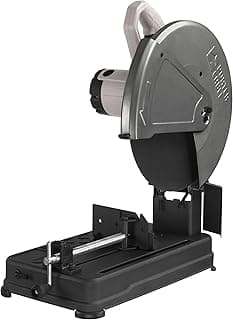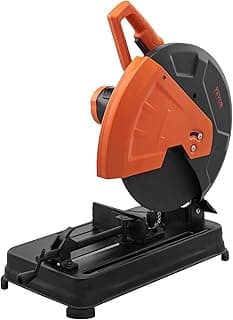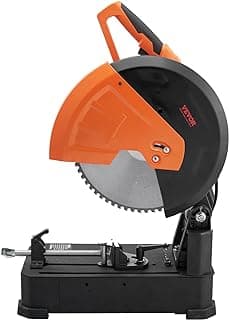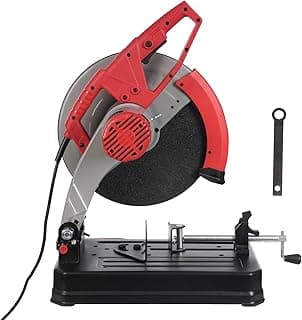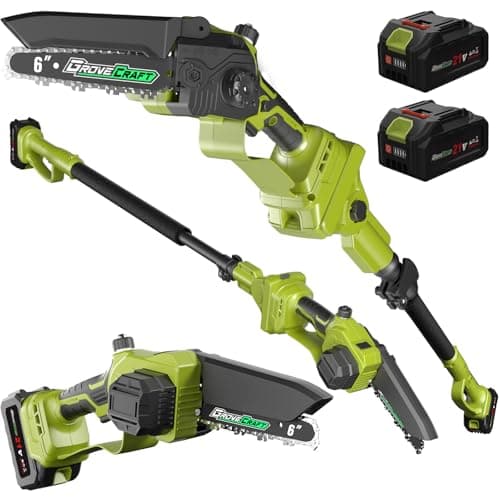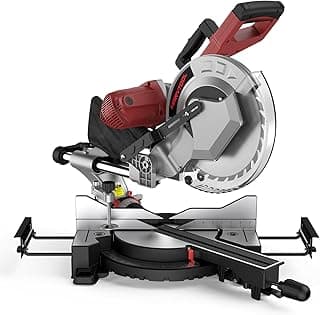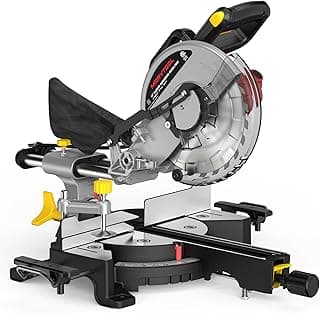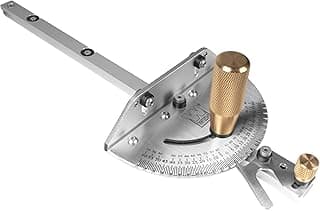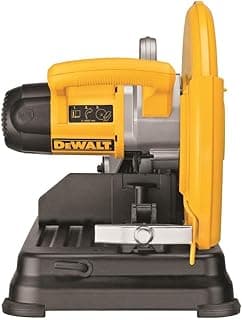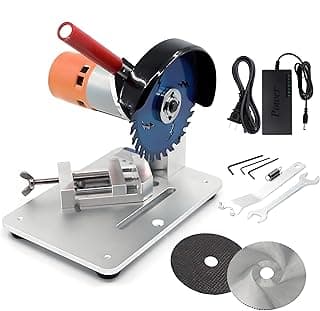If you frequently work with metal, having the right saw can make all the difference. Choosing the best steel cut off saws ensures clean, accurate cuts while saving time and effort. But with so many options available, it can be overwhelming to decide which tool suits your needs. That’s where this guide comes in.
First, we’ll look at essential considerations like blade types, teeth per inch (TPI), and saw design. Along the way, we’ll reference the best steel cutting sawzall blades for compatibility with portable saws, and also explore how the best metal cutting saw compares in terms of precision and ease of use.
By the end of this review, you’ll understand not only which saws perform best for steel but also which features will improve your workflow. Stick with us—we’ll break it down step by step so your next cut is flawless.
Top Picks
Best Compact Metal Cutter: SKIL 12 In. Metal Dry Cut Saw with Diablo Blade- SPT62MTC-22
Despite its compact size, the Skil metal-cutting saw delivers impressive performance that rivals larger 14-inch models. With a 4-1/2-inch cutting capacity, it handles various metal profiles with precision and speed. The Cermet-tipped blade technology stands out for its ability to cut faster and cleaner than traditional abrasive chop saws, producing minimal sparks and burrs. This makes it ideal for workshop environments where efficiency and safety are priorities. The die-cast aluminum frame adds durability while keeping the unit light enough for easy transport, an advantage for professionals who move between job sites. Its soft-start motor helps prevent sudden jerks at startup, prolonging motor life and ensuring smoother operation over time.
From a user perspective, this saw earns strong marks for convenience and cutting efficiency. Many appreciate the cleaner cuts and reduced post-cut finishing compared to abrasive wheels. The tool’s balanced weight and ergonomic design also make it comfortable for extended use. However, as a corded model, its portability is somewhat limited when working in areas without easy power access. Overall, it’s a powerful, portable solution for users who need clean, fast, and reliable metal cuts without the bulk of a full-size chop saw.
Best Dry-Cut Precision: Evolution S355CPSL – Heavy Duty 14 Inch Metal Cutting Chop Saw
The Evolution S355CPSL is engineered for professionals who demand both precision and durability in a metal-cutting saw. Its 15-amp motor provides consistent power for cutting through mild steel and other metals with ease, while the pressed steel base offers a solid yet portable foundation. The dry-cut technology is a standout feature, allowing for cooler operation and burr-free results. Unlike abrasive saws that generate heat and sparks, this model delivers smooth, ready-to-use edges with minimal cleanup.
Users appreciate the adjustable miter feature, which enables accurate angle cuts from 0 to 45 degrees. The quick-release vise and fence system further streamline the process, ensuring secure workpiece clamping and faster adjustments. With support for various blade types, the saw accommodates different materials, making it versatile enough for high-volume or workshop use.
From customer feedback, many highlight the machine’s clean, consistent performance and long-lasting blade quality. The cool cutting experience and minimal spark output make it safer and more efficient for indoor use. Some users note that its weight, while adding stability, slightly reduces portability compared to lighter models. Still, with its robust build, precision features, and dependable three-year warranty, the Evolution S355CPSL remains a top-tier choice for those who value accuracy, longevity, and professional-grade results.
Best Compact Dry Cutter: Evolution Power Tools EVOSAW185 Chop Saw TCT Steel Cutting
The Evolution EVOSAW185 is a compact yet powerful solution for users who need clean, precise cuts on metal materials. Despite its smaller frame, it efficiently handles a variety of applications—ranging from steel plates and square tubes to conduit and rebar. The 10-amp high-torque motor delivers impressive power for its size, ensuring smooth, consistent performance even under demanding workloads.
This model’s dry-cut technology eliminates the heat, burrs, and sparks typically associated with abrasive saws, producing cleaner finishes that require little to no post-processing. The quick-release adjustable vise enhances efficiency, allowing users to make accurate angled cuts up to 45 degrees with minimal setup time. Its steel construction adds durability, while the lightweight design makes it easy to transport between job sites.
From a user standpoint, the EVOSAW185 earns praise for its balance of portability, power, and precision. Customers often highlight the cooler cutting process and reduced cleanup, making it ideal for indoor or workshop environments. However, its smaller blade size does limit cutting depth, making it less suitable for very large stock materials. Overall, it’s an excellent choice for professionals and DIY users seeking a compact, clean-cutting metal saw with reliable performance and minimal maintenance.
FAQs
What Type of Saw Is Best for Cutting Steel?
When it comes to cutting steel, there are a few saw types that excel:
-
Metal Cut Off Saws – Also known as chop saws, these stationary saws are designed specifically for cutting metal. They offer stability, high RPMs, and precise, straight cuts.
-
Bandsaws – Ideal for larger or irregular pieces, bandsaws provide smooth cuts and reduce material waste. They work well for both steel and aluminum.
-
Angle Grinders – While more versatile, they require steady hands and proper safety measures. With the correct cut-off wheel, they can handle steel effectively.
-
Reciprocating Saws – Equipped with metal-cutting blades, these are best for demolition or rough cuts rather than precision work.
For precision and efficiency, a stationary metal cut off saw usually outperforms handheld options in both speed and accuracy.
Is 18 or 24 TPI Better for Metal?
TPI, or Teeth Per Inch, determines how fine or aggressive a cut will be:
-
18 TPI: Provides faster cutting for thinner steel and soft metals but may create rougher edges. Ideal for general-purpose cuts.
-
24 TPI: Produces smoother, cleaner cuts and works better on harder metals or thicker steel. Slower than 18 TPI but reduces burrs and improves finish quality.
In general, choose higher TPI for hard or thick steel and lower TPI for speed on thin metals. Many professional users keep both options on hand depending on the task.
What Are the Different Types of Metal Cut Off Saws?
Metal cut off saws can be categorized based on power source, design, and blade type:
-
Manual (Handheld) Cut Off Saws – Lightweight, portable, and suitable for smaller jobs. Blade size and RPM are limited compared to stationary saws.
-
Electric Stationary Cut Off Saws – High precision and ideal for workshop use. Can handle a wide range of steel thicknesses.
-
Cold Saws – Use a toothed blade and slow RPM to cut steel with minimal heat, leaving a clean edge. Perfect for high-quality finishes.
-
Abrasive Cut Off Saws – Use friction discs to cut steel. Faster and cheaper but produce heat and sparks, which can affect the metal.
Each type serves different purposes, so your choice depends on precision, speed, and project scale.
What Is the Best Saw Blade to Cut Through Metal?
Selecting the right blade is essential for both efficiency and safety:
-
High-Speed Steel (HSS) Blades – Durable and can cut mild steel and non-ferrous metals.
-
Bi-Metal Blades – Combine flexibility and durability, perfect for tougher metals like stainless steel.
-
Carbide-Tipped Blades – Ideal for extremely hard or abrasive materials. They last longer but are more expensive.
-
Abrasive Wheels – Common for quick cuts, though they produce more heat and can wear down quickly.
For precision cuts, a bi-metal blade with higher TPI is generally the best balance of speed, durability, and finish quality.
Final Thoughts
Choosing the best steel cut off saws comes down to matching your saw type and blade to the material and project requirements. Stationary metal cut off saws provide accuracy and power, while handheld and portable options offer flexibility for smaller jobs. Understanding TPI, blade materials, and saw design ensures clean cuts, minimal waste, and long-lasting performance.
By combining the right saw with the best steel cutting sawzall blades or a high-quality metal cutting blade, you can tackle any steel cutting task efficiently and safely. Whether for a workshop or on-site project, investing in the right tool guarantees precision and durability.






